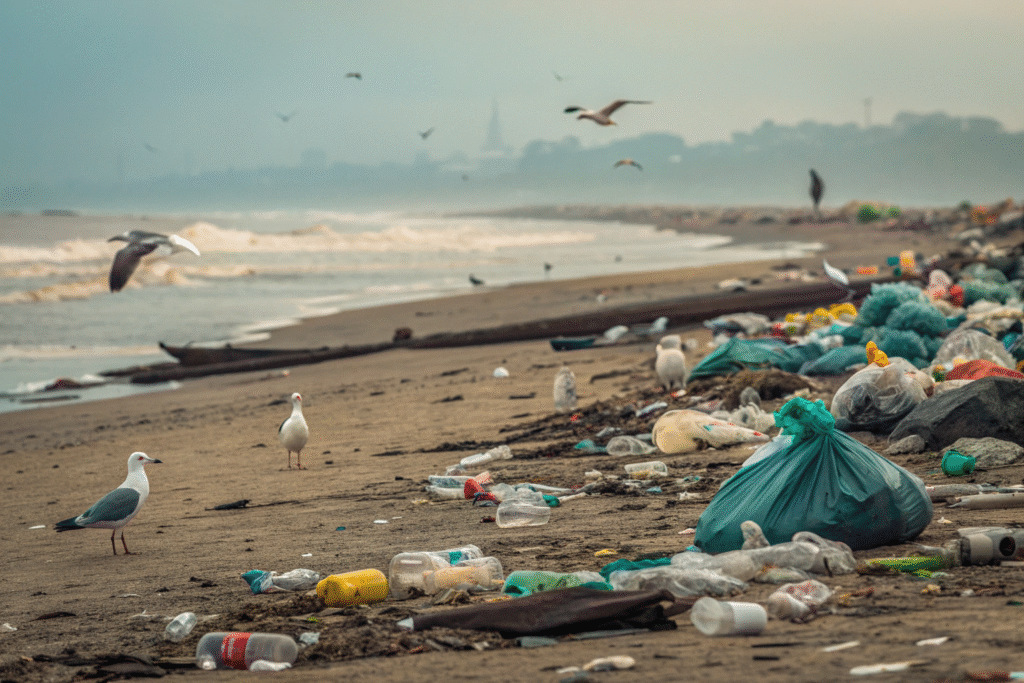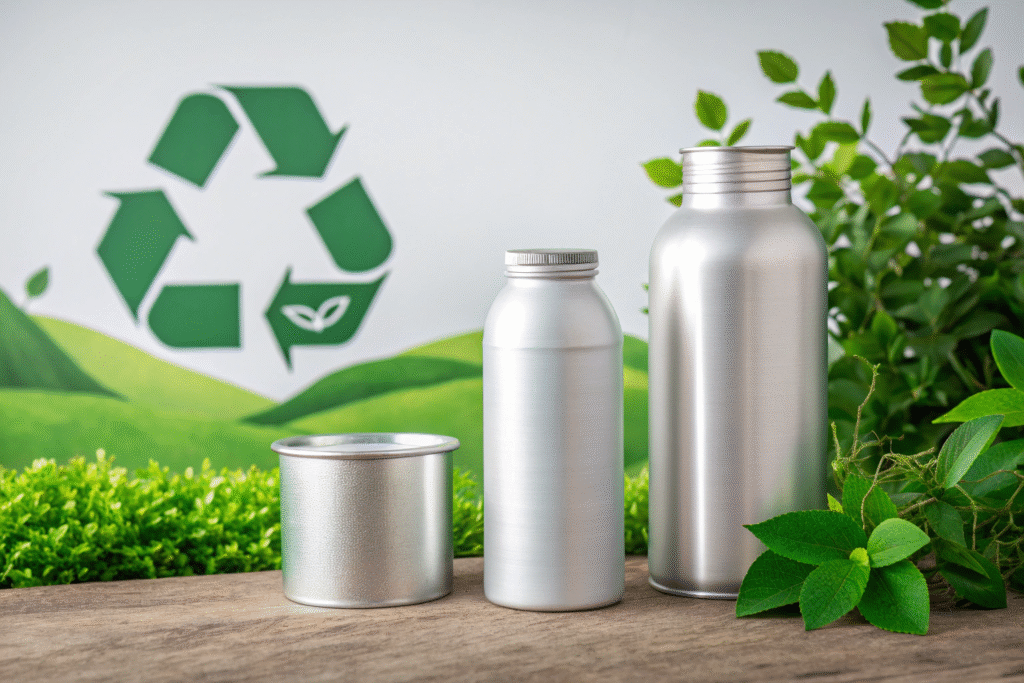Take a walk down any grocery aisle. You’ll see a sea of plastic: bottles, tubs, jugs, and shrink-wrapped containers. It’s a landscape of convenience, but it hides a silent crisis. For decades, we’ve been told a story about plastic-that it’s a disposable wonder, easily recycled and managed. That story is a myth. The reality is that our planet is choking on plastic. From the deepest oceans to the highest mountains, single-use plastic has become a permanent pollutant. It’s time to face the truth and embrace a solution that’s been hiding in plain sight: aluminum packaging.
The Disposable Crisis: Understanding the True Cost of Plastic
The problem with plastic goes far beyond litter. It’s a systemic issue with devastating environmental consequences that we can no longer ignore.
The Recycling Illusion
Despite our best efforts, only a tiny fraction of plastic is ever recycled. The latest statistics reveal a stark reality: PET plastic bottles have a recycling rate of just 20%, compared to aluminum cans at 43%. Even more concerning, plastic degrades each time it’s reprocessed, a process known as “downcycling.” Your plastic bottle will never become another bottle; it might become a carpet fiber or a park bench before ultimately ending up in a landfill. When evaluating sustainable packaging options, the recycling rates and environmental impact must be primary considerations. The EPA’s recent assessment shows varying recycling rates across materials, with aluminum at 36.9%, PET bottles at 23.2%, and HDPE bottles at 22.7%. These numbers tell a clear story about which materials are actually making it through the recycling system.
The Microplastic Plague
Plastic never truly disappears. It breaks down into microscopic particles that have infiltrated everything-our water, our soil, our food, and even our bodies. Recent studies highlight significant environmental concerns, with over 25 million tons of plastic pollution in global waters. These microplastics harm wildlife and pose unknown risks to human health, creating a legacy of pollution that will outlive us all.
A Fossil Fuel Product
Most plastics are derived from fossil fuels. Their production releases immense amounts of greenhouse gases, directly contributing to climate change from the moment they are created to the moment they are burned or left to decay. EPA data reveals that plastic packaging generates 14.5 million tons of waste annually, with a staggering 69% ending up in landfills. Sounds familiar, right? We’ve all heard about the plastic problem, but what’s less discussed is the viable alternative that’s been with us all along.
Why Do Other Materials Fall Short?

Naturally, we look for alternatives to plastic. But common substitutes have their own critical flaws that make them less than ideal solutions.
Glass: Heavy and Fragile
While infinitely recyclable, glass is heavy and fragile. Its weight dramatically increases carbon emissions during transportation, and its energy-intensive manufacturing process leaves a significant environmental footprint. When poorly separated from waste streams, glass ends up in landfills, negating its recyclability.
Paper & Cardboard: Limited Protection
While renewable, paper-based packaging struggles to protect against moisture and oxygen, making it unsuitable for preserving liquids and fresh foods. Furthermore, its production often involves deforestation and heavy chemical and water usage, which can harm ecosystems.
Rediscovering the Power of Aluminum
The most effective, sustainable, and proven packaging solution has been with us all along: the can. Primarily made of aluminum or steel, cans offer a powerful combination of benefits that plastic and glass simply cannot match. Among sustainable packaging examples, aluminum cans stand out with their 43% recycling rate compared to just 20% for PET plastic bottles. This isn’t just a small improvement-it’s a fundamental difference in how these materials function in our waste stream.
A True Circular Champion
Aluminum is 100% and infinitely recyclable without any loss in quality. Recycling an aluminum can saves an astonishing 95% of the energy required to make a new one from raw materials. This makes it the world’s most recycled beverage container and a cornerstone of a true circular economy. The sustainable packaging coalition provides guidelines that help businesses evaluate the true environmental impact of their packaging choices. According to their standards, materials that support a circular economy should be prioritized-and aluminum fits this description perfectly.
Ultimate Product Protection
Cans provide a hermetic seal, creating an absolute barrier against light, oxygen, and moisture. This naturally preserves the flavor, freshness, and nutritional value of food and beverages without the need for chemical preservatives. When comparing sustainable packaging options, it’s crucial to consider the entire lifecycle from production to disposal, including how well the packaging protects what’s inside.
Lightweight and Efficient
Cans are incredibly lightweight and durable. This not only reduces the risk of product loss from breakage but also significantly lowers carbon emissions during shipping and distribution. Unlike glass, which is prone to damage and breakage, aluminum cans can withstand the rigors of transportation without compromising their integrity or recyclability.
Aluminum vs. Plastic Packaging
When we directly compare these materials across key environmental factors, the differences become even clearer:
Recycling Performance
The latest recycling statistics reveal significant differences between plastic and aluminum packaging materials:
| Material Type | Recycling Rate (2023) | Closed-loop Circularity | Recycled Content |
| Aluminum Cans | 43% | 96.7% | 71% |
| Plastic Bottles | 20% | 34% | 3-10% |
These numbers tell a powerful story. Not only are aluminum cans recycled at more than twice the rate of plastic bottles, but the aluminum that does get recycled is far more likely to become another can. This closed-loop system is what true sustainability looks like.
Energy & Production Impact
Ever wondered why your packaging choices matter so much for the environment? The production processes for both materials show distinct environmental footprints:
| Impact Factor | Aluminum | Plastic |
| Production Emissions | 450% higher than plastic | Lower baseline emissions |
| Energy Requirements | Highly energy-intensive | Less intensive production |
| Resource Extraction | Significant bauxite mining impact | Lower extraction impact |
| Transportation Efficiency | Higher energy costs | More efficient due to lighter weight |
This is where the story gets more complex. Virgin aluminum production does require more energy than plastic production. However, this initial energy investment is offset by aluminum’s infinite recyclability and the massive energy savings achieved through recycling.
Long-Term Environmental Risk
The principles of sustainable packaging design favor materials that can be infinitely recycled without quality loss. When we look at the long-term environmental risk, aluminum clearly outperforms plastic:
- Aluminum can be recycled indefinitely, creating a true circular system
- Plastic degrades with each recycling cycle and ultimately becomes waste
- Aluminum doesn’t break down into harmful microparticles in the environment
- Plastic persists for hundreds of years, fragmenting into microplastics
Looking at sustainable packaging examples across industries reveals that aluminum consistently outperforms plastic in circularity metrics. The shift toward sustainable packaging has become essential as consumers demand eco-friendly alternatives to traditional materials.
The Role of Organizations in Promoting Sustainable Packaging
The Green Canning Foundation is dedicated to safeguarding our planet and fostering sustainable living through the thoughtful reuse of materials and minimizing waste. They empower communities with practical knowledge, host workshops, and support projects that connect environmental responsibility with economic and social well-being. Effective sustainable packaging design must balance environmental impact with practical considerations like product protection and shelf life. Through hands-on canning workshops, upcycling programs, and clean-up campaigns, organizations like the Green Canning Foundation don’t just talk sustainability – they make it tangible. Many brands are exploring sustainable packaging options that reduce their carbon footprint while maintaining product integrity. The industry is setting ambitious targets, with the aluminum industry aiming for:
- 70% recycling rate by 2030
- 80% by 2040
- 90% by 2050
Businesses that invest in sustainable packaging often see increased customer loyalty and brand reputation benefits. It’s not just good for the planet-it’s good for business.
Making Better Packaging Choices
A solution is only as good as our ability to use it. That’s why organizations like the Green Canning Foundation are so important-they bridge the gap between knowing what’s better for the environment and actually implementing those solutions. At the Green Canning Foundation, packaging is viewed not only as a technical necessity but also as an opportunity for social and environmental impact. By supporting local businesses and providing education on sustainable packaging choices, such organizations help ensure that innovation translates into real environmental progress. Through partnerships and outreach, they:
- Strengthen Community Impact – Guiding microbreweries, cafés, and artisanal food producers in adopting recyclable, low-impact packaging strengthens local economies while reducing waste.
- Promote the Circular Economy – Every can reused or recycled represents a step toward a system where resources circulate rather than end up in landfills.
- Bridge Economic and Ecological Goals – Many small producers worry about balancing costs with sustainability. The right canning solutions show that both goals can be achieved.
The Clear Choice for Our Planet’s Future
The evidence is clear: when it comes to sustainable packaging, aluminum outperforms plastic in the metrics that matter most for our planet’s future. While no packaging solution is perfect, aluminum’s infinite recyclability, superior protection properties, and established recycling infrastructure make it the better choice for environmentally conscious consumers and businesses. The next time you’re faced with a packaging choice, remember:
- Aluminum can be recycled forever without losing quality
- Plastic recycling is limited and often results in downcycling
- Aluminum cans have more than twice the recycling rate of plastic bottles
- The energy saved by recycling aluminum offsets its higher production energy
By choosing aluminum over plastic, you’re not just making a one-time decision-you’re supporting a truly circular system that can continue to function indefinitely without depleting our planet’s resources or filling our oceans with waste. What packaging choices will you make today? The future of our planet may depend on it.

